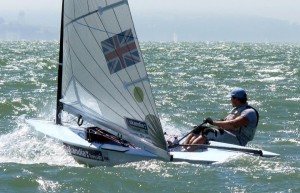Simple Tuning Guide…
Scope of this guide.
 What follows is a basic guide to setting up your Finn. It is aimed at helms new to the class or returning after a long break from Finn sailing and will definitely not get you to the next Olympics. What it should do is help you to get up the first few rungs of the ladder without too much pain by giving a overview of how things work today, and some pointers of where to find further information.
What follows is a basic guide to setting up your Finn. It is aimed at helms new to the class or returning after a long break from Finn sailing and will definitely not get you to the next Olympics. What it should do is help you to get up the first few rungs of the ladder without too much pain by giving a overview of how things work today, and some pointers of where to find further information.
-
The Mast: It is not an accident that the mast is first on the list as together with the sail it is THE most important part of the Finn. All modern masts are of carbon fibre construction and have a wing section and this is the the direction you should be heading if you are serious about your sailing. Being an Olympic class there is constant development in this field which does mean that new masts are rather expensive, but they do last a long time and a spin off of this is that good second hand masts become available as people move on. There are still a number of round or oval section carbon masts around which will provide reasonable performance and a few aluminium Needlespar masts for the classics, however the latter should be inspected closely especially if sailed at sea as corrosion is inevitable due to age. One point to note when buying a second-hand mast is the position of the deck ring with relation to the foot as this does vary on some earlier boats, for example a Mk5 Vanguard hull has the ring some 20mm lower than a modern Devoti hull so the only option in this case is to move the deck ring to suit.
Next Event
Day(s)
:
Hour(s)
:
Minute(s)
:
Second(s)
-
Mast / Sail Combination: Regardless of what mast you have it will only give you the best performance if the sail fits it. When buying a new sail the sail maker will need to know the bend characteristics or ‘Numbers’ of your mast to add the correct luff curve, similarly if buying a second-hand sail you should ask the vendor the numbers of the mast the sail was cut for. Remember, even if this sail is in perfect condition and won this year’s Nationals it will not perform for you if the luff curve mast is totally different from that for which it was cut! However, all may not be lost as sail manufacturers such as North Sails will re-cut their own sails at a modest charge.
-
Mast Numbers: The bend characteristics of the mast are obtained by supporting the mast at the foot and deck ring and hanging a 10kg or 12kg weight (depending on which sail manufacture you go to) on the end and measuring the deflection at 1/4, 1/2 and 3/4 distance along the mast. This gives measurements for both fore/aft and sideways bend, however, we only tend to quote the fore/aft number when selling second hand. As a rule a North sail will have numbers relating to a 10kg weight and a WB sail will have 12kg numbers so it pays to know which maker you are going for or alternatively get both sets of numbers. As a guide using 10kg figures a fore/aft deflection at half point for a medium bend mast would be around 108mm which would suit helms in the region of 90kg. A figure of around 100mm using the same weight is a stiff mast for 100kg plus helms. The 1/4 and 3/4 fore/aft figures ideally should be roughly the same and around 75% of the mid point figure.
-
Mast Rake: The rake of the mast determines the leach tension of the sail. The sail manufacturer has an optimum leach tension in mind when he makes the sail, however, the leach tension will vary for a given rake and wind strength depending on how stiff the mast is so the figures given in the table below are really only a starting point. To measure the mast rake first prop up the front of the launching trolley so the transom of the boat rests on the ground and then hoist a tape up the mast measuring between the band at the top and the cut out in the aft deck where it meets the transom. A good rake to start off with is 676cm and then sail the boat upwind with the boom on the deck and look at the leach tell tails. If they are all streaming out OK you are probably not too far away, but at the end of the day the only way is to sail against other boats and make adjustments to see the effect (don’t forget to make a note of the settings as it is all too easy to forget!) Most sailors now use a tension gauge to set the recommended leech tension advised by the sail maker, as an example click here for the North Sails guide to checking leech tension. Once you are happy with the rake you can balance the rudder feel (amount of helm) by moving the whole rig forwards or backwards. This is achieved as with most other boats by picking a force 2-3 wind and setting off upwind with the boom down to the deck and the rig fully powered up. With the boat UPRIGHT the helm should be as near neutral as possible – move the rig aft to increase weather helm or forward to reduce it. The board is another great tool in increase and decrease the helm (feel) on the boat. In the light move the board to maximum forward (bringing it closer to the mast), and as the wind increases move the board back in the boat to reduce the helm.
-
Deck Controls: The four controls should be in the following order (from front to back): 1st Downhaul (cunningham), 2nd Inhaul, 3rd Outhaul, 4th Kicker. This gives the two you use most nearest you, important when you’re surfing down waves in a breeze as you definitely do not want to be scrabbling around up front for the kicker when you prepare to gybe!
-
Hulls Devoti is the main supplier in the UK and these have been around since the mid 1990’s, with Pata and now Petticrows also popular. Prior to this Vanguard was the main manufacture and now represents much of the classic with carbon fleet. Which you decide depends entirely on available funds but do not be put off too much by age as Finns are generally built like brick out-houses and go on for a long while if looked after – most people tend to keep hulls for a number of seasons and it is common for one hull to have had a number of different rigs.
The table below gives a basic guide to settings for different wind strengths:
|
Wind Seed (mph)
|
0-8
|
8-12
|
12-16
|
16-20
|
20-25
|
25-30
|
30 and above
|
|
Mast Rake (cm)
|
6.74
|
6.75-6.76
|
6.77
|
6.77
|
6.75-6.76
|
6.75
|
6.74-6.75
|
|
Distance from boom to deck (cm)
|
35-25
|
25- 10
|
10 – 0
|
0
|
0
|
0
|
0-5
|
|
Position of end of boom with respect to gunnel
|
Slightly in
|
Slightly in
|
Slightly in to level
|
Start to let traveller out beyond gunnel as wind increases
|
Carry on letting out
|
Carry on letting out
|
Carry on letting out
|
|
Inhaul (cm)
|
7-5
|
5-3
|
3-1
|
2-1
|
2-1
|
2-3
|
2-3
|
|
Outhaul (cm)
|
5-7
|
6-8
|
5-7
|
6-4
|
5-3
|
4-2
|
2-0
|
|
Downhaul
|
None
|
None
|
Slight
|
Slight |
Medium
|
Medium
|
On hard
|
For further information on tuning, check out the videos on the The Finn Channel






